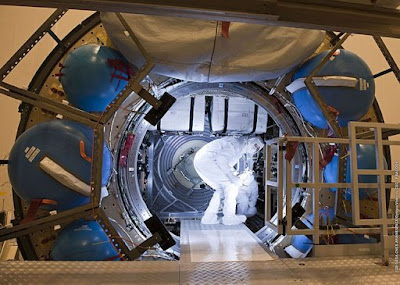ESA's ATV-4 (Albert Einstein), a robotic freighter bearing 6.6 tonnes of cargo docked with the International Space Station (ISS) on Saturday, the European Space Agency (ESA) said.
The fourth of ESA's Automated Transfer Vehicles (ATVs) berthed with the ISS 10 days after being launched by Ariane 5 rocket from Europe's spaceport in Kourou, French Guiana, it said.
The resupply ship, named after Albert Einstein, is laden with food, water, oxygen, science experiments and special treats for the ISS astronauts.
It made contact with the ISS at 1407 GMT, the ESA said, about 20 minutes later than originally expected.
The robot space freighter is the size of a double-decker bus—10 metres (33 feet) long and 4.5 metres (15 feet) in diameter.
It is designed to find its way automatically to the ISS, navigating by starlight and using its onboard thrusters to gently dock with the manned orbital outpost.
ESA is contracted to build five ATVs as part of its contribution to the US-led ISS project.
During its four-month mission, the ATV will act as a store room and additional living quarters for the ISS.
It will also use its thrusters to boost the station, which is in low Earth orbit and loses altitude because of lingering atmospheric friction, to higher altitudes.
The ATV is set to undock in October filled with about six tonnes of garbage and human waste, and burn up over the Pacific.
The fourth of ESA's Automated Transfer Vehicles (ATVs) berthed with the ISS 10 days after being launched by Ariane 5 rocket from Europe's spaceport in Kourou, French Guiana, it said.
The resupply ship, named after Albert Einstein, is laden with food, water, oxygen, science experiments and special treats for the ISS astronauts.
It made contact with the ISS at 1407 GMT, the ESA said, about 20 minutes later than originally expected.
The robot space freighter is the size of a double-decker bus—10 metres (33 feet) long and 4.5 metres (15 feet) in diameter.
It is designed to find its way automatically to the ISS, navigating by starlight and using its onboard thrusters to gently dock with the manned orbital outpost.
ESA is contracted to build five ATVs as part of its contribution to the US-led ISS project.
During its four-month mission, the ATV will act as a store room and additional living quarters for the ISS.
It will also use its thrusters to boost the station, which is in low Earth orbit and loses altitude because of lingering atmospheric friction, to higher altitudes.
The ATV is set to undock in October filled with about six tonnes of garbage and human waste, and burn up over the Pacific.








No comments:
Post a Comment